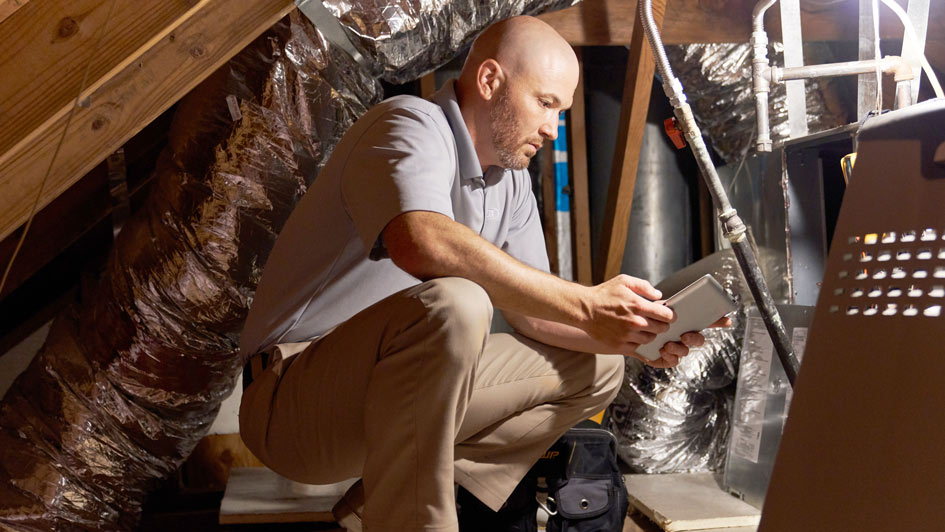
Where you aware that more than 50% of your home’s energy costs are for your heating and cooling? That’s why it’s critical to maintain an energy-efficient HVAC system.
Furnace efficiency standards were last revised to an Annual Fuel Utilization Efficiency (AFUE) rating of 80% in 2015. This rating system calculates how effective your furnace is at turning natural gas into heat. An AFUE rating of 80% means your furnace wastes about 20% of the fuel it uses while generating heat.
In 2022, the U.S. government recommended new energy-efficiency standards for residential gas furnaces that would substantially lower emissions, save consumers money and stimulate sustainability.
This proposal is expected to:
- Save Americans $1.9 billion annually.
- Cut carbon emissions by 373 million metric tons and methane emissions by 5.1 million tons over 30 years, the equivalent of what 61 million homes emit annually.
Starting in 2029, the proposed rule would demand all new gas furnaces to feature AFUE ratings of 95%. This means furnaces would convert nearly 100% of the gas into usable heat.
With these facts in mind, you may be asking yourself "what happens to my existing furnace"? Currently, next to nothing, as the proposed rule won't go into effect until 2029 at the earliest and will not affect furnaces that are already in use.
But if your furnace is nearing the end of its life and a replacement is needed in soon, highly energy-efficient furnaces are now available. Learn how these furnaces can save you money on your utility bills.
Guide to Condensing Furnaces
How Condensing Furnaces Work
A condensing furnace is a kind of heating system that uses a secondary heat exchanger to collect wasted heat from the furnace's exhaust gases. This decreases the amount of energy wasted, improves energy efficiency and lowers carbon-monoxide emissions. It also will take less natural gas to produce the same amount of heat when comparing one to other types of furnaces.
How Condensing Furnaces Differ from Non-Condensing Furnaces
The biggest difference between a condensing furnace and a non-condensing furnace is condensing models use a secondary heat exchanger to capture any wasted heat from its exhaust gases, while the other does not.
Expected Longevity of a Condensing Furnace
The life span of a condensing furnace depends on the brand, model and other factors. Generally speaking, a condensing furnace will last between 10-20 years with sufficient maintenance and regular service. If you put off scheduled maintenance, it may not last as long.
Why Condensing Furnaces Require a Higher Investment
For the most part, condensing furnaces are more expensive than non-condensing furnaces. This is due to their increased efficiency and the extra components needed to capture any wasted heat from its exhaust gases. However, the extra energy savings can help recoup the cost of purchase. So over time, it may be more cost efficient to consider investing in a condensing furnace.
Guide to Variable-Speed Furnaces
Variable-Speed Furnaces: What You Need to Know
A variable-speed furnace can more precisely alter its fan speed to better meet the heating needs of your home. It starts at a slower speed until it notices a drop in temperature and then ramps up to produce more heat. This [precise fan is significantly more efficient than traditional furnaces, as it only uses the minimum amount of energy needed to heat your home, which subsequently saves money on your utility bills.
The majority of variable-speed furnaces are condensing furnaces, although some are available in non-condensing models with lower AFUE ratings. If a manufacturer wants a furnace to be classified as a condensing furnace, it must offer an AFUE rating of 90% or higher.
Do Variable-Speed Furnaces Run Constantly?
A variable-speed furnace doesn’t operate all the time. Rather, it runs at different speeds according to the temperature in your Wyandotte home as well as the amount of energy it requires to reach that temperature.
When sufficient energy is demanded to maintain your set temperature level, the furnace will increase to a higher speed to manage the higher demand. Doing this will ensure more efficient heating in your home while also offering quieter operation.
Guide to Two-Stage Furnaces
Two-Stage Furnaces: What They Are and How They Work
A heating system with two settings of operating - high and low - is called a two-stage furnace. On the low stage, the furnace operates at a reduced capacity in order to maintain the chosen temperature for your home more efficiently. During the high stage, the furnace will instead operate at full capacity to satisfy demands for more heat. With a two-stage furnace, you can experience improved energy efficiency and comfortable temperatures everywhere in your home.
While two-stage furnaces are extremely efficient, not all all models are condensing furnaces.
Does a Two-Stage Furnace Function All the Time?
A two-stage furnace should not run constantly. In the low stage of operation, the furnace runs at limited capacity in order to maintain a preferred temperature more efficiently within your home. When more energy is needed to reach the set temperature, the furnace will switch to its high stage and runs at full capacity. As a result, two-stage furnaces are powerful enough to help reduce energy costs without operating constantly.
Contrasting Two-Stage and Variable-Speed Furnaces
Two-stage furnaces have two stages of operation, low and high. During the low stage, the furnace works at reduced capacity in order to maintain a desired level of comfort within your home. When additional warmth or cooling is necessary, the furnace will switch to its high stage and operate at maximum capacity.
Variable-speed furnaces, meanwhile, can work at several speeds in order to maintain a more precise temperature at home. As such, variable-speed furnaces offer greater savings on your utility bills .
Differences Between One- and Two-Stage Furnaces
One-stage furnaces have a single stage of operation and operate either at full capacity or not at all. As a result, the furnace is always running in order to maintain a desired level of comfort at home.
Conversely, two-stage furnaces have two stages of operation, low and high. While in the low stage, the furnace runs at lower capacity in order to maintain the desired temperature more efficiently. When more warmth or cooling is necessary, the furnace will change over to its high stage and operate at maximum capacity.
Schedule Your Furnace Installation with Gee & Missler Heating & Air Conditioning Today
It takes experience and dedication to stay up to date about furnace technology advancements. That’s why Gee & Missler Heating & Air Conditioning experts are here to help with a no-cost, no-pressure quote for furnace installation. We’ll assess your home, your heating needs and your budget before helping you find the ideal solution. Call us at 734-284-1224 to get started today!


